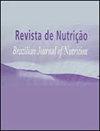Consumption of differently processed food by public school adolescents
IF 0.5
4区 医学
Q4 NUTRITION & DIETETICS
Revista De Nutricao-brazilian Journal of Nutrition
Pub Date : 2022-01-01
DOI:10.1590/1678-9865202235e210078
引用次数: 0
Abstract
ABSTRACT Objective To characterize food consumption, considering the degree of industrial food processing by public schools’ adolescents. Methods Cross-sectional study involving adolescents aged 14 to 19 years, of both genders, attending public schools in Juiz de Fora, MG. Food consumption was assessed using two 24-hour dietary recalls. Foods were classified into three groups according to the degree of industrial processing: (1) unprocessed foods or minimally processed foods, culinary ingredients and preparations based on these foods; (2) processed foods; (3) ultra-processed foods. In addition, weight and height information was collected, with subsequent calculation of body mass index/age to assess the individuals’ nutritional status according to the gender. Pearson’s chi-square, Mann-Whitney and Kruskal-Wallis tests were performed, adopting a value of p<0.05. Results The sample consisted of 804 adolescents, with a predominance of females (57.5%). In the sample, 29.9% and 26.1%, of girls and boys, respectively, were overweight. There was a difference in the daily consumption of ready-made sweet-tasting foods, being higher in females (26.2%) when compared to males (18.1%), whereas the consumption of soft drinks (one to four times a week) was 47.2% and 55.6% in girls and boys, respectively (p<0.05). Higher consumption of ultra-processed foods was observed in females (p=0.02) and processed foods in males (p=0.008). Conclusion There was a high contribution of ultra-processed foods in the diet of adolescents in public schools; a high prevalence of overweight was observed in both genders.公立学校青少年食用不同加工食品的情况
【摘要】目的了解公立学校青少年食品消费特征,并考虑其工业化食品加工程度。方法横断面研究纳入14至19岁的青少年,男女,在Juiz de Fora, MG公立学校就读。通过两次24小时饮食回顾来评估食物消耗。根据工业加工程度将食品分为三类:(1)未加工食品或最低限度加工食品、烹饪配料和基于这些食品的制剂;(二)加工食品;(3)超加工食品。此外,收集体重和身高信息,随后计算体重指数/年龄,根据性别评估个体的营养状况。采用Pearson卡方检验、Mann-Whitney检验和Kruskal-Wallis检验,p<0.05。结果青少年804人,以女性为主(57.5%)。在样本中,分别有29.9%的女孩和26.1%的男孩超重。在每日食用现成甜味食物方面,女性的比例(26.2%)高于男性(18.1%),而饮用软饮料(每周一至四次)的女孩和男孩分别为47.2%和55.6% (p<0.05)。女性(p=0.02)和男性(p=0.008)对超加工食品的消费较高。结论公立学校青少年饮食中超加工食品的比例较高;在两性中均观察到较高的超重患病率。
本文章由计算机程序翻译,如有差异,请以英文原文为准。
求助全文
约1分钟内获得全文
求助全文
来源期刊
CiteScore
1.20
自引率
12.50%
发文量
24
审稿时长
6-12 weeks
期刊介绍:
Revista de Nutrição is former Revista de Nutrição da Puccamp, founded in 1988. It is a bimonthly publication every four months and it is of responsibility of the Centro de Ciências da Vida, da Pontifícia Universidade Católica de Campinas . It publishes articles that contribute to the study of Nutrition in its many sub-areas and interfaces; and is open to contributions of the national and international scientific communities.

 求助内容:
求助内容: 应助结果提醒方式:
应助结果提醒方式:


